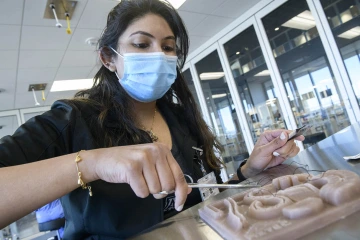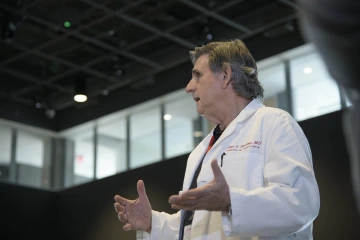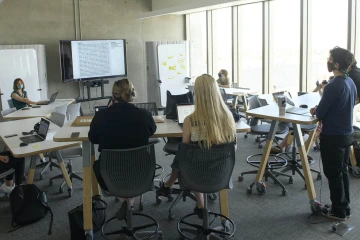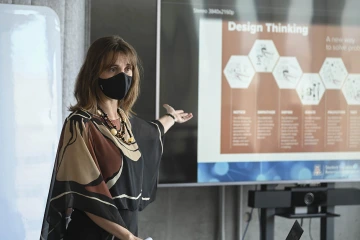Evolving Health Care Landscape Spurs New Training Approaches
As gaps between health care needs and current solutions become more apparent, innovative education programs are preparing students for the future.
Several global trends are on the rise that are significantly influencing the delivery of health care today and for future generations. The world’s population is growing older and more diverse, advancements in health technology are expanding the personalization of care, and the needs of medically underserved communities – whether tied to geography or demography or both – are more acute than ever before.
To address these widespread and emergent issues, the University of Arizona Health Sciences is preparing students to build and lead the future of health care.
Removing barriers to broaden the physician workforce
At the forefront of educating the next generation of health care professionals is a commitment to expanding a diverse student body and equipping them to provide patient-centered care within the changing health care landscape.

UArizona Health Sciences is preparing students to build and lead the future of health care.
However, for potential physicians who come from underrepresented backgrounds, the prospect of significant student debt is discouraging many from applying to medical school. Many of these individuals are in diverse communities that point to the country’s demographic future.
“For too many young women and men who are hoping to have a future in medicine, the prospect of overwhelming student debt has become an outsized factor in whether they will be able to put their passion for healing into practice,” said Michael D. Dake, MD, senior vice president for UArizona Health Sciences. “This is especially true for those who may be the first in their communities to become a doctor, and who would bring unique perspectives to providing culturally sensitive care to Arizona’s diverse populations.”
“Health care is an art and a science. We want to be able to address all of it, and we can only do that when we bring together all of the different skillsets that we have.”Allan Hamilton, MD, FACS
Among several programs to remove barriers to broaden the physician workforce, Health Sciences developed the Primary Care Physician Scholarship Program to address primary care disparities caused by student debt concerns. The scholarships are funded by a portion of $8 million approved by the Arizona Legislature and Gov. Doug Ducey in 2019.
Available to incoming and current students at the Colleges of Medicine in Tucson and Phoenix, the scholarship allows medical students to pursue careers in the traditionally lower-paying primary care practice areas without worrying about how they will repay their medical school debt.
In exchange for medical school tuition, recipients commit to practice primary care in a rural or urban underserved Arizona community for as long as four years, depending on how many years they receive the scholarship.
High-tech training for the future
Preparing students for real-world situations is an integral part of the educational process. Today, faculty in the five colleges that compose Health Sciences use leading-edge simulation technology to make that happen.

Allan Hamilton, MD, FACS, executive director of the Arizona Simulation Training and Education Center, strives to provide students opportunities to gain technical knowledge as well as learn vital mental and social skills.
“It is our charge at UArizona Health Sciences to ensure that our educational model is fully developed,” said Allan Hamilton, MD, FACS, executive director of the Arizona Simulation Training and Education Center (ASTEC). “We must provide every opportunity for students to acquire the mental, social and technical skills required to navigate this new world of health care.”
Spanning some 30,000 square feet inside the Health Sciences Innovation Building on the Tucson campus, ASTEC provides interprofessional learning opportunities in a realistic simulated environment.
“We can’t assure that every medical student or resident is going to see every type of case in actual patients during their training,” said Dr. Hamilton, a Regents Professor of surgery in the UArizona College of Medicine – Tucson. “The goal of ASTEC is to be able to reproduce every environment where medicine or health care is delivered and practiced, and come up with every permutation that we need to train people.”
Dr. Hamilton emphasized the ability to simulate procedures that may be rare for medical students to experience or perform first-hand. One such procedure is a tracheostomy, which is an opening surgically created through the neck into the trachea (windpipe) to allow direct access to a breathing tube. Using a 3D printer and silicone, ASTEC created an artificial model with life-like skin that bleeds when cut, just as it would on a human patient. In a simulated environment, training students on such procedures can happen without life-threatening consequences.

A new course, Design for Care Workshop: Addressing Healthcare Challenges with Design Thinking, uses experiential and project-based collaborative learning to teach undergraduate and graduate students how to apply design thinking principles to solve health and wellness challenges.
“We want you to make the worst mistakes of your life here,” said Dave Biffar, MS, CHSOS-A, assistant director of operations for ASTEC. “Our mission is to teach people how to prevent and eliminate all medical errors.”
Dr. Hamilton is looking forward to launching new interprofessional education modules that combine students from each of the UArizona Health Sciences colleges into multidisciplinary teams. The students would be presented with a scenario or problem and work together to reach a collective solution.
“Health care is an art and a science,” Dr. Hamilton said. “We want to be able to address all of it, and we can only do that when we bring together all of the different skill sets that we have.”
Health care education by design
The modern health care curriculum at UArizona Health Sciences enables students to engage with one another while bringing real-world problems to the forefront of classroom discussions. For the first time in Spring 2021, undergraduate and graduate students were able to enroll in a Health Sciences Design Thinking course.

Kasi Kiehlbaugh, PhD, is teaching students new human-centered approaches to solving today’s health care challenges.
Led by Kasi Kiehlbaugh, PhD, director of the Health Sciences Design program, the course taught students to use a human-centered process to solve problems. Students collaborated and applied design thinking principles learned in the class to address real-world health and wellness problems.
“This human-centered lens is important because it allows us to approach a problem from different perspectives,” Dr. Kiehlbaugh said. “We want students to consider how various people are experiencing that problem. Understanding these different perspectives oftentimes produces different, more impactful solutions.”
In future semesters, Dr. Kiehlbaugh envisions classes that include students from the five Health Sciences colleges, and others from a variety of academic backgrounds, including English, humanities, drama, math and other departments across campus.
“We are giving students access to unique educational experiences where they can take their own disciplinary knowledge gained throughout their academic career and apply it in the context of human health and wellness,” Dr. Kiehlbaugh said.
Contact
Blair Willis
520-626-2101
bmw23@arizona.edu

